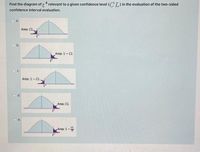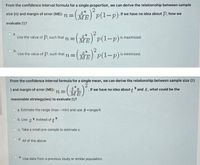
A First Course in Probability (10th Edition)
10th Edition
ISBN: 9780134753119
Author: Sheldon Ross
Publisher: PEARSON
expand_more
expand_more
format_list_bulleted
Question
7

Transcribed Image Text:Find the diagram of t * relevant to a given confidence level (CL) in the evaluation of the two-sided
confidence interval evaluation.
a.
Area: CL,
O b.
Area: 1- CL
Area: 1- CL
d.
Area: CL
e.
Area: 1-.

Transcribed Image Text:size (n) and margin of error (ME): n = M E) P(I-p). If we have no idea about P, how we
From the confidence interval formula for a single proportion, we can derive the relationship between sample
=(E) P(1-p)
evaluate n?
3(E) P(1-p)*
a.
Use the value of P, such that
is maximized.
n =
МЕ
b.
Use the value of P, such that
=(B) P(1-p)"
n3D
is minimized.
МЕ
From the confidence interval formula for a single mean, we can derive the relationship between sample size (n
) and margin of error (ME):
ts
ME
. If we have no idea about + * and 8, what could be the
n =
reasonable strategy(ies) to evaluate n?
a. Estimate the range (max - min) and use S=range/4.
b. Use z * instead of t*.
c. Take a small pre-sample to estimate s.
O d.
All of the above.
e.
Use data from a previous study or similar population.
Expert Solution
This question has been solved!
Explore an expertly crafted, step-by-step solution for a thorough understanding of key concepts.
Step by stepSolved in 2 steps with 2 images

Knowledge Booster
Similar questions
- 10 ろarrow_forwardThe number of dollars a round trip plane ticket costs from North America to Europe is normally distributed with a mean of $1,780 and a standard deviation of $335. What is the probability a randomly selected ticket costs between $775 and $2,785? Enter your answer in decimal form. For example. 75% should be entered as 0.75arrow_forwardM-Buhen Marrow_forward
arrow_back_ios
arrow_forward_ios
Recommended textbooks for you
 A First Course in Probability (10th Edition)ProbabilityISBN:9780134753119Author:Sheldon RossPublisher:PEARSON
A First Course in Probability (10th Edition)ProbabilityISBN:9780134753119Author:Sheldon RossPublisher:PEARSON

A First Course in Probability (10th Edition)
Probability
ISBN:9780134753119
Author:Sheldon Ross
Publisher:PEARSON
